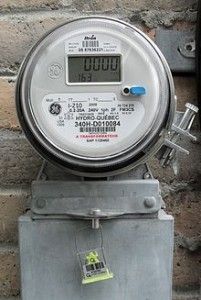PG&E misleads on rate increases
by CalWatchdog Staff | November 27, 2012 9:24 am
 [1]Editor’s Note: This is Part 2 of two. Part 1 is here[2].
[1]Editor’s Note: This is Part 2 of two. Part 1 is here[2].
Nov. 27, 2012
By Katy Grimes
PG&E has openly misled about rate increases. In February 2011, PG&E announced[3] the utility expected its electric rate to remain steady into 2011. Then it was revealed that PG&E’s 2011-2013 General Rate Case would bring more rate increases.
As I wrote in February, “The game was clever: While decreasing the rates by 0.8 percent on January 1, 2011, and increasing rates again by 1.5 percent on March 1, the net result was an increase of 0.7 percent. PG&E got its rate increase.”
Every three years, General Rate Cases provide the California Public Utilities Commission a chance to perform an exhaustive review of utility company revenues, expenses, and investments into utility infrastructure.
And every three years, PG&E requests rate increases, and the CPUC approves them.
Remember[4] that PG&E charged its customers $5 million to fix a gas pipeline under San Bruno, Calif. in 2009, but delayed the work, citing other priorities. The company then spent $5 million on executive bonuses. The subsequent 2010 San Bruno gas pipeline explosion killed eight, injured more than 100 and destroyed 38 homes.
High rates
PG&E’s rates are already among the highest in the United States and are higher than almost all municipal providers. In General Rate Cases, PG&E has repeatedly double-dipped, and tried to charge customers millions in deferred maintenance, on which repairs may or may not be done.
The CPUC has failed miserably[5] at any oversight of the utility giant, as well as at the enforcement of necessary maintenance to gas lines.
According to the Independent Review Panel report [6]following the deadly San Bruno gas pipeline explosion[7], PG&E management had focused primarily on compensation and investments, instead of leading pipeline safety and integrity in the industry, despite warnings.
The damning report[8] also identified several factors contributing to a dysfunctional culture at PG&E: excessive levels of management, lack of expertise within management, appearance-led strategy setting, insularity and overemphasis on financial performance.
It would appear to anyone that the CPUC has allowed PG&E to operate with little accountability[9], and perhaps only cursory oversight. State government has not applied its own laws, rules and regulations evenly, and appears to have allowed the largest utilities to get away with gross negligence.
Whose charity?
PG&E not only pays counties hefty property taxes. The utility also makes charitable contributions to local food banks, chambers of commerce, health programs, and “underserved communities.”
In 2011, PG&E made more than $23 million in charitable contributions[10]. According to PG&E, “More than 75 percent of PG&E’s community investments provided assistance to underserved communities in 2010. This funding supported projects and organizations assisting people with low incomes, communities of color, women, veterans, senior citizens, people with disabilities, and members of the lesbian, gay, bisexual and transgender community.”
“[PG&E] officers sit on the boards of a diverse group of nonprofits, such as California State Parks Foundation[11], United Negro College Fund[12] and Leadership California[13].”
Also, “We worked with the Association of Bay Area Governments[14], Association of Monterey Bay Area Governments[15], Great Valley Center[16] and Sierra Business Council[17] to help compile greenhouse gas inventories for more than 60 local governments. These are expected to be completed in 2011 and we plan to get started on roughly 60 more.”
The counties become news when agencies spoke out in favor of PG&E’s corporate interests. But ratepayers shouldn’t have to fund any of PG&E’s charitable or political spending. Ratepayers can choose to make such contributions on their own.
Ratepayers pay
PG&E has argued that the shareholders pay for these expenditures. But all of PG&E’s revenues first come from ratepayers. Shareholders make their money off of the ratepayers.
The CPUC looked at PG&E’s last rate hike request and apparently had a difficult time with the justification, according to one utility expert who asked to remain anonymous. He said the dividends paid to shareholders should be closer to 5 to 7 percent, as for most utilities, not more than 11 percent.
“Going back five years, PG&E never reduced the dividends, even as rates were increased,” said the utility expert.
The CPUC has historically allowed utility companies continually to increase rates, resulting in California becoming the most expensive state in the entire country for utility rates.
- [Image]: http://www.calwatchdog.com/2012/11/27/pge-misleads-on-rate-increases/electricity-rate-meter-wikipedia/
- here: http://www.calwatchdog.com/2012/11/26/lax-cpuc-oversight-lets-pge-gouge-ratepayers/
- announced: http://www.pge.com/about/newsroom/newsreleases/20110228/pgampe_electric_rate_holding_steady_into_2011.shtml
- Remember: http://www.calwatchdog.com/2011/10/17/cpuc-stuck-in-culture-of-corruption/
- failed miserably: http://www.calwatchdog.com/2011/10/17/cpuc-stuck-in-culture-of-corruption/
- Independent Review Panel report : http://www.cpuc.ca.gov/PUC/events/110609_sbpanel.htm
- San Bruno gas pipeline explosion: http://www.calwatchdog.com/2011/09/01/feds-blast-pge-and-utilities-commission/
- report: http://www.cpuc.ca.gov/NR/rdonlyres/85E17CDA-7CE2-4D2D-93BA-B95D25CF98B2/0/cpucfinalreport_v2.pdf
- little accountability: http://www.calwatchdog.com/2011/10/17/cpuc-stuck-in-culture-of-corruption/
- charitable contributions: http://www.pge.com/about/community/contributions/
- California State Parks Foundation: http://www.calparks.org/
- United Negro College Fund: http://www.uncf.org/
- Leadership California: http://www.leadershipcalifornia.org/i4a/pages/index.cfm?pageid=1
- Association of Bay Area Governments: http://www.abag.ca.gov/
- Association of Monterey Bay Area Governments: http://www.ambag.org/
- Great Valley Center: http://www.greatvalley.org/
- Sierra Business Council: http://www.sbcouncil.org/
Source URL: https://calwatchdog.com/2012/11/27/pge-misleads-on-rate-increases/